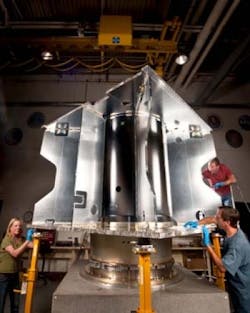Lockheed Martin builds NASA MAVEN spacecraft primary structure
Lockheed Martin engineers in the Composites Lab constructed the 275-pound MAVEN’s primary structure, which is cube-shaped at measuring 7.5 feet x 7.5 feet x 6.5 feet high (2.3 meters x 2.3 meters x 2 meters high), out of composite panels with aluminum honeycomb sandwiched between graphite composite face sheets. The center of the structure is a 4.25-foot (1.3-meter)-diameter core cylinder (the primary vertical load-bearing structure) which houses a hydrazine propellant tank, able to hold approximately 3,615 pounds (1640 kilograms) of fuel.
NASA Goddard personnel manage the project and will build some instruments for the mission. Lockheed Martin engineers in Littleton, Colo., are building the spacecraft and will perform mission operations. The University of California-Berkeley Space Sciences Laboratory is also building instruments for the mission. NASA's Jet Propulsion Laboratory, Pasadena, Calif., will provide navigation support, the Deep Space Network, and the Electra telecommunications relay hardware and operations.
"Seeing the core structure reinforces the fact that MAVEN is no longer just a set of ideas that scientists and engineers have come up with; it is starting to become a spacecraft," says Guy Beutelschies, MAVEN program manager at Lockheed Martin Space Systems Company.
"There's still a lot of work to go before we have the complete spacecraft, but this is a major step in getting us to the launch pad in two years. All the team's hard work now will pay off when we get to Mars and see the science results," says Bruce Jakosky, MAVEN principal investigator from the Laboratory for Atmospheric and Space Physics at the University of Colorado (CU/LASP) at Boulder.
